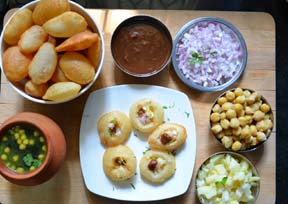 The most common street snack of India has many names. In North India, it is widely called Golgappa, in Mumbai, Maharasthra, it is called as Pani Puri, and it is referred to as Pakodi in some interior parts of Gujarat.
The most common street snack of India has many names. In North India, it is widely called Golgappa, in Mumbai, Maharasthra, it is called as Pani Puri, and it is referred to as Pakodi in some interior parts of Gujarat.
The name of this street snack may vary from region to region, but the ingredients remain almost same. It is essentially a round shaped, hollow fried crisp puri filled with the mixture of delicious and sour flavored water (pani) or tamarind chutney or chaat masala which is a mixture of onion and chilli chickpeas. Here are the many names of India’s favorite snack.
1. Pani Puri
This is the most popular name in most parts of India and the world. Pani Puri is used in Maharashtra, Gujarat, Madhya Pradesh, Karnataka, Tamil Nadu and even in parts of Nepal. Although addressed by the same name in all these regions, the pani puri greatly varies in taste. While in Mumbai it is predominantly the hot ragda (thick white peas curry) variety that you get with the meetha imli chutney, in Madya Pradesh, there is potato mash added and no boondi in the water. In Gujarat, the tradition is to add finely diced potatoes with some boiled moong, sweet chutney made of dates and boondi added to the paani. In Bangalore, onions are also added to the mix.
2. Puchka
More famous in Eastern India (West Bengal and Assam) as Puchka, the snack is also called by the same name in Bangladesh. Puchkas are quite different from pani puris in terms of content and taste. Puchkas use a mixture of boiled gram and mashed potatoes as the filling, the chutney is tangy rather than sweetish and the water is spicy. Puchkas are also slightly bigger in size and the puris are darker in color. Bihar and Jharkhand also know the delicious snack as Puchka.
3. Gol Gappe
The delicious snack of puris filled with tangy water is known as Gol Gappe in Northern India. Almost all of North India, except Haryana, refers to it as Gol Gappe. The taste in Northern India is pretty much the same and it is a favorite. With Gol Gappa stalls lining every street and corner, this is probably equivalent to North India what Vada Pav is to Maharashtra. Gol Gappe are made from a mix of potato and chickpea stuffing, chutney and very tangy water. The water has a dash of mint and lots of spices added to it. Also, in some places in North India, the puris for the Gol Gappe are not very round but slightly longish.
4. Pakodi
Do not confuse these with the very famous pakodas, but pani puri is referred to as Pakodi in some interior parts of Gujarat. The taste and the preparation remains similar though there are considerable differences. Sev is sometimes an interesting addition to Pakodi in some places. Pakodis generally leave the sweet chutney out but incorporate onions. The water is heavy on mint and green chillies. Quite a deviation from the sweet-spicy snack, pakodis are quite stuffed and spicy.
5. Paani ke Patashe
Literally translated from both the main ingredients of the dish, puris and the tangy water, Paani ke Patashe is what pani puri is called in parts of Haryana. The taste though is quite similar to that of Gol Gappe.
6. Patashi
Not to be confused with the sweet made of sugar, Patashi is another name for pani puri. Popular as Patashi or Paani ke Batashe in Rajasthan and Uttar Pradesh the main ingredients here involve the use of different spices for the water though the filling stays the same, i.e, potatoes and chickpeas or gram. In Lucknow, one can taste Paani ke Batashe with 5 different types of water, called Paanch Swaad ke Batashe (spheres of 5 tastes), famous at Hazratganj. The water for Patashi is generally made from dry mangoes.
7. Gup Chup
Pani puris are called Gup Chup in parts of Odisha, South Jharkhand, Chhatisgarh, Hyderabad, and Telangana because of the sound they make when the puris burst and the water fills the mouth. Gup Chups generally consist only of boiled chickpeas or white peas and spicy water, eliminating the potatoes. As a result, they are much lighter to eat. Onions are not always added but can be, on request.
8. Phulki
While Gujaratis refer to chapati as phulkas, pani puri is called Phulki in the eastern parts of Uttar Pradesh and some regions of Nepal. The preparation for Phulki is the standard and it is only the name that differs. Phulki is traditionally not used as it is often confused with the Ramadan savory of Dahi Phulki, which is essentially dahi vadas where the vadas are made of chickpeas instead of split black lentils. Phulki is not very common and rarely used though.
9. Tikki
It is only in Hoshangabad in Madhya Pradesh where pani puri is referred to as Tikki. For the rest of the world, Tikkis are aloo tikkis but for these guys, tikkis are yummy puris stuffed with potatoes or chickpeas and dipped in tangy water!
10. Padaka
Once again, a one-off name, Padaka is what the people of Aligarh, Uttar Pradesh, call pani puri.
-Courtesy South Asian Post






